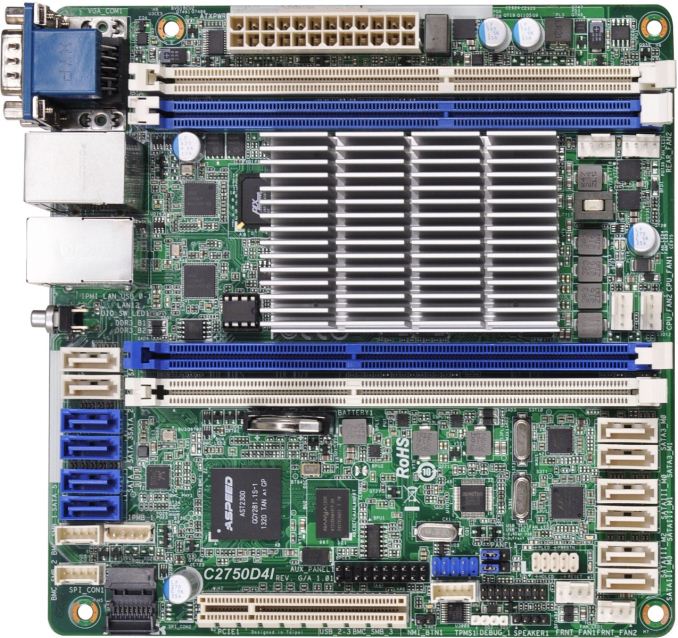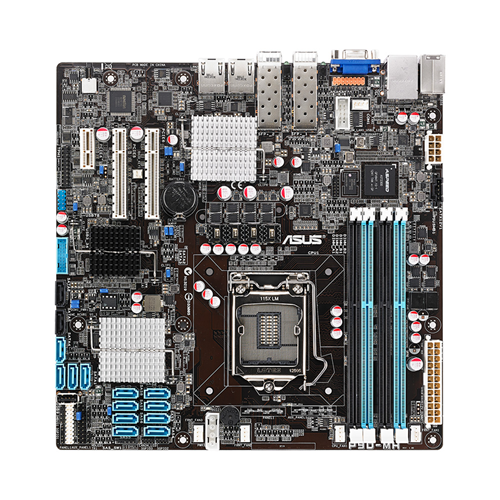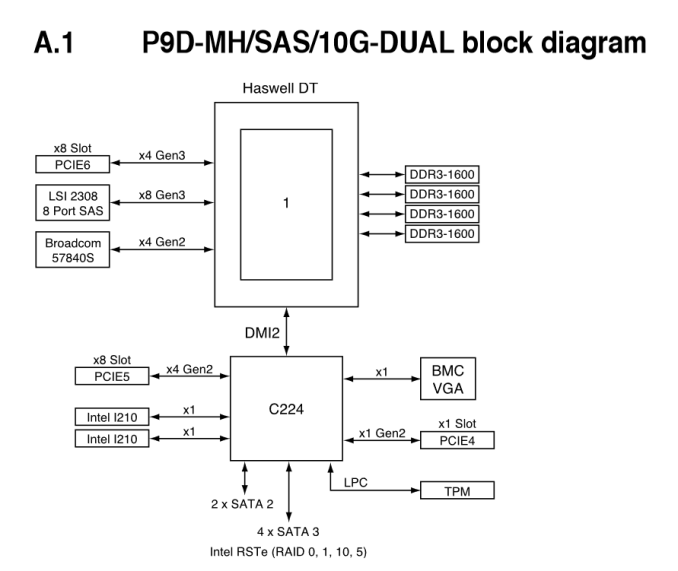X-Gene 1, Atom C2000 and Xeon E3: Exploring the Scale-Out Server World
by Johan De Gelas on March 9, 2015 2:00 PM ESTLow-End Server Building Blocks
Micro and low-end servers come in all shapes and forms. Ideally, we would gather them all in our labs and make a performance per watt comparison, taking the features that make management easier into account. The reality is that while lots of servers enter our lab, many of the vendors cannot be easily convinced to ship heavy and expensive server chassis with a few tens of nodes.
In AnandTech tradition, we decided to take a look at the component level instead. By testing simple motherboard/CPU/RAM setups and then combining those measurements with the ones we get from a full blown server, we can get a more complete picture. A simple motherboard/CPU/RAM setup allows us the lowest power numbers possible, and a full blown server measurement tells us how much the more reliable cooling of a full blown server chassis adds.
ASRock's C2750D4I
The mini-ITX ASRock C2750D4I has the Atom "Avoton" C2750 SoC (2.4GHz, eight Silvermont cores) on board. If you are interested in using this board at home, Ian reviewed it in great detail. I'll focus on the server side of this board and use it to find out how well the C2750 stacks up as a server SoC.
Contrary to the Xeon E3, 16GB DIMMs are supported. The dual-channel, four DIMM slot configuration allows you to use up to 64GB. This board is clearly targeted at the NAS market, as ASRock not only made use of the six built-in SATA ports (2x SATA 6G, 4x SATA 3G) of the Atom SoC but also added a Marvell SE9172 (2x SATA 6G) and a Marvell SE9230 (4x SATA 6G) controller. Furthermore, ASRock soldered two Intel i210 gigabit chips and an AST2300 to the board. However, the Atom "Avoton" integrated 16 PCIe lanes only support four PCIe devices. The PCIe x8 slot already needs eight of them and the Marvel SE9230 takes another two PCIe lanes, so the ASRock board needs a PLX 8608 PCIEe switch.
The end result is that the ASRock C2750 board consumes more energy at idle than a simpler micro server board would. We could not get under 26W, and with four DIMMs 31W was needed. That is quite high, as Supermicro and several independent reviews report that the Supermicro A1SAM-2750F needs about 17W in the same configurations.
ASUS P9D-MH
The micro-ATX ASUS P9D-MH is a feature rich Xeon E3 based board. ASUS targets cloud computing, big data, and other network intensive applications. The main distinguishing feature is of course the dual 10 Gigabit SFP+ connectors of the Broadcom 57840S controller.
The C224 chipset provides two SATA 3G ports and four SATA 6G ports. ASUS added the LSI 2308 controller to offer eight SAS ports. The SAS drives can be configured to run in a RAID 0/1/10 setup.
The Xeon E3-1200v3 has 16 integrated PCIe 3.0 lanes. Eight of them are used by the LSI 2308 SAS controller, and the 10 Gigabit Ethernet controller gets four fast lanes to the CPU. That leaves four PCIe 3.0 lanes for a mechanical x8 PCIe slot.
The second x8 PCIe slot gets four PCIe 2.0 slots and connects to the C224 chipset. The remaining PCIe 2.0 lanes are used by the BMC, the PCIe x1 slot, and the dual gigabit Ethernet controller.
Of course, all these features come with a price. With the efficient Xeon E3-1230L (25W TDP) and four 8GB DIMMs, the board consumes 41W at idle.













47 Comments
View All Comments
Wilco1 - Tuesday, March 10, 2015 - link
GCC4.9 doesn't contain all the work in GCC5.0 (close to final release, but you can build trunk). As you hinted in the article, it is early days for AArch64 support, so there is a huge difference between a 4.9 and 5.0 compiler, so 5.0 is what you'd use for benchmarking.JohanAnandtech - Tuesday, March 10, 2015 - link
You must realize that the situation in the ARM ecosystem is not as mature as on x86. the X-Gene runs on a specially patched kernel that has some decent support for ACPI, PCIe etc. If you do not use this kernel, you'll get in all kinds of hardware trouble. And afaik, gcc needs a certain version of the kernel.Wilco1 - Tuesday, March 10, 2015 - link
No you can use any newer GCC and GLIBC with an older kernel - that's the whole point of compatibility.Btw your results look wrong - X-Gene 1 scores much lower than Cortex-A15 on the single threaded LZMA tests (compare with results on http://www.7-cpu.com/). I'm wondering whether this is just due to using the wrong compiler/options, or running well below 2.4GHz somehow.
JohanAnandtech - Tuesday, March 10, 2015 - link
Hmm. the A57 scores 1500 at 1.9 GHz on compression. The X-Gene scores 1580 with Gcc 4.8 and 1670 with gcc 4.9. Our scores are on the low side, but it is not like they are impossibly low.Ubuntu 14.04, 3.13 kernel and gcc 4.8.2 was and is the standard environment that people will get on the the m400. You can tweak a lot, but that is not what most professionals will do. Then we can also have to start testing with icc on Intel. I am not convinced that the overall picture will change that much with lots of tweaking
Wilco1 - Tuesday, March 10, 2015 - link
Yes, and I'd expect the 7420 will do a lot better than the 5433. But the real surprise to me is that X-Gene 1 doesn't even beat the A15 in Tegra K1 despite being wider, newer and running at a higher frequency - that's why the results look too low.I wouldn't call upgrading to the latest compiler tweaking - for AArch64 that is kind of essential given it is early days and the rate of development is extremely high. If you tested 32-bit mode then I'd agree GCC 4.8 or 4.9 are fine.
CajunArson - Tuesday, March 10, 2015 - link
This is all part of the problem: Requiring people to use cutting edge software with custom recompilation just to beat a freakin' Atom much less a real CPU?You do realize that we could play the same game with all the Intel parts. Believe me, the people who constantly whine that Haswell isn't any faster than Sandy Bridge have never properly recompiled computationally intensive code to take advantage of AVX2 and FMA.
The fact that all those Intel servers were running software that was only compiled for a generic X86-64 target without requiring any special tweaking or exotic hacking is just another major advantage for Intel, not some "cheat".
Klimax - Tuesday, March 10, 2015 - link
And if we are going for cutting edge compiler, then why not ICC with Intel's nice libraries... (pretty sure even ancient atom would suddenly look not that bad)Wilco1 - Tuesday, March 10, 2015 - link
To make a fair comparison you'd either need to use the exact same compiler and options or go all out and allow people to write hand optimized assembler for the kernels.68k - Saturday, March 14, 2015 - link
You can't seriously claim that recompiling an existing program with a different (well known and mature) compiler is equal to hand optimize things in assembler. Hint, one of the options is ridiculous expensive, one is trivial.aryonoco - Monday, March 9, 2015 - link
Thank you Johan. Very very informative article. This is one of the least reported areas of IT in general, and one that I think is poised for significant uptake in the next 5 years or so.Very much appreciate your efforts into putting this together.